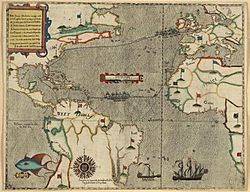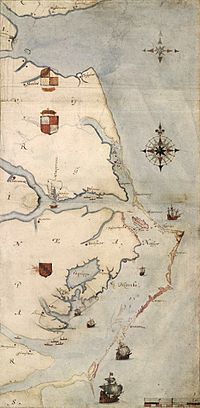Raid on St. Augustine facts for kids
Quick facts for kids Raid on St. Augustine |
|||||||||
|---|---|---|---|---|---|---|---|---|---|
| Part of the Anglo–Spanish War | |||||||||
 Sir Francis Drake in St. Augustine 1586 hand-colored engraving, by Baptista Boazio, 1589 |
|||||||||
|
|||||||||
| Belligerents | |||||||||
|
|
|||||||||
| Commanders and leaders | |||||||||
| Governor Pedro Menéndez de Márquez | Sir Francis Drake Christopher Carleill |
||||||||
| Strength | |||||||||
| 100 soldiers & militia Unknown number of Indians 2 forts |
23 ships, 19 support vessels & prizes, 1,000 troops |
||||||||
| Casualties and losses | |||||||||
| 35 killed or wounded | Light | ||||||||
The Raid on St. Augustine was an important event during the Anglo-Spanish War. In May 1586, an English fleet led by Sir Francis Drake attacked the Spanish settlement of St. Augustine in Florida. The English captured the town after a short fight and then burned it down.
This attack was part of Sir Francis Drake's "Great Expedition." It was his last stop in the Spanish Main (the northern coast of South America and the Caribbean) before he sailed north to the Roanoke Colony. This expedition also made the Spanish leave their settlements and forts in what is now South Carolina.
Contents
Why the Raid Happened
A war had already started between Spain and England. Philip II of Spain was angry because Elizabeth I of England had supported the Protestant Dutch rebels who were fighting against Spanish rule.
Queen Elizabeth I, through her advisor Francis Walsingham, told Sir Francis Drake to lead a trip to attack Spain's colonies in the New World. This was like a "first strike" to weaken Spain.
Drake sailed from Plymouth, England, in November 1585. First, he attacked Santiago in the Cape Verde islands, off the coast of Africa. Then, he crossed the Atlantic Ocean. On January 1, 1586, he captured the Spanish city of Santo Domingo and made them pay a ransom. After that, he successfully attacked the important city of Cartagena on February 19.
Drake wanted to attack one more Spanish city before visiting Sir Walter Raleigh's new Roanoke Colony on the American east coast. After that, he planned to sail back to England. The fleet sailed north. In late April, Drake stopped in Cuba. His men dug wells for fresh water and gathered supplies because many of them were sick with dysentery. Then, they moved on.
The fleet sailed north along the coast of the Florida peninsula. On May 27, 1586, they saw a small fort on the shore. There was also a small water channel nearby. This was the location of St. Augustine, the most northern Spanish town in the New World. Drake knew about St. Augustine. He also knew that the Spanish, led by Pedro Menéndez de Avilés, had killed French Huguenot settlers who tried to live in the area. Drake decided this was a good chance to raid the town and get revenge for his fellow Protestants.
The English Attack St. Augustine
The English ships attacked a small wooden fort on the sand dunes. The Spanish soldiers inside fired only a few shots and then ran away. Drake sent a group of men to check the fort. Meanwhile, Christopher Carleill, who was a captain, and some other volunteers rowed a small boat into the water channel. They didn't see any Spanish soldiers. The fort was on a strip of sand, separated from the mainland by water.
A French Huguenot named Nicholas Borgoignon was found in a boat. He had been captured by the Spanish six years earlier. He agreed to guide the English to the Spanish settlement.
The Spanish governor of St. Augustine was Pedro Menéndez de Márquez. He was the nephew of Pedro Menéndez de Avilés. He had been warned that Drake was nearby. He knew he had fewer than a hundred soldiers and couldn't fight Drake's large force. The Spanish settlers moved inland. They hoped to make surprise attacks against the English later.
Drake and his men took over the small fort. But during the night, Native American allies of the Spanish attacked. Drake and his men fought back. Within twenty minutes, the Native Americans were forced to retreat, and some were killed.
The next day, Drake, Carleill, and about two hundred men went up the water channel in small boats. Soon, they found the main Spanish fort, called San Juan. It was made of logs. After a few shots from the Spanish, the English landed and took the fort. They had only a few losses. They found the fort empty because the Spanish had fled.
However, they found a gun platform with fourteen bronze cannons. They also found a chest with the soldiers' pay, about 2,000 gold coins, which the Spanish had accidentally left behind. Drake knew the Spanish had run away. He began to take everything valuable. He took the cannons and burned the fort to the ground.
Soon, the English reached the main settlement of St. Augustine itself. This time, they found it deserted too. But the Spanish were just outside the town when Drake's men arrived. They started shooting. Anthony Powell, one of Carleill's officers, was killed as he tried to attack the edge of the town. Carleill's men then charged into the bushes outside the town. This forced the Spanish to retreat, and Drake took control of the settlement.
The English stayed in the town overnight. The next day, they completely destroyed St. Augustine. All the buildings were burned. Crops were ruined. Anything valuable was taken or destroyed. The San Juan fort was burned, and all the cannons were taken by the English, along with other treasures.
What Happened Next
After the English left, Governor Menéndez and the Spanish settlers returned. They found only smoking ruins and very little left of their town. Menéndez quickly asked for help from the Spanish leader in Cuba. It took a long time for the settlement to be rebuilt. The destroyed San Juan fort was replaced with another wooden fort. A stronger stone fort, the Castillo de San Marcos, was not built until 1672.
Visiting Roanoke
Drake's fleet left St. Augustine on May 29. They sailed north along the coast, looking for signs of Raleigh's settlement. They sailed into what is now Charleston Harbor but found it empty. They continued up the coast until they saw smoke. A boat was sent to investigate. Its crew finally met the English settlers, who were living on Roanoke Island. Drake didn't have many supplies, but he offered to take any of the settlers back to England. He sailed into Portsmouth on July 22.
Drake was seen as a national hero when he arrived in England. By then, news of his brave raids on the Spanish Main had reached most of Europe. His direct attacks on the Spanish Empire were a big blow to Spain's reputation. They also threatened the flow of silver and gold from the New World into Spain's treasury. The Spanish called Drake El Draque, which means "The Dragon," and thought of him as a terrible pirate. Drake's attacks on the Spanish colonies embarrassed the Spanish king, Philip II. This made him even more determined to invade and conquer England.
Impact of the Raid
Drake's raid had a big impact on the Spanish. Soon, rumors spread that the English had a settlement further north. People thought the English were using it as a base for piracy. This was confirmed when released Spanish prisoners said Drake wanted to resupply the Roanoke colony. Even though the Spanish knew about Roanoke, they couldn't find the English colony, despite sending out several military groups. Menéndez got very close, reaching 37 degrees latitude, but he didn't find anything.
The Spanish feared another raid. Their settlements on the American West coast were spread out, didn't have enough men, and lacked weapons. This caused a crisis. Menéndez even talked with the Council of the Indies in Seville (who confirmed St. Augustine's destruction by July) and King Philip II. He argued that all efforts should focus on one place: St. Augustine. Menéndez got his way despite some disagreements. As a result, Parris Island and Santa Elena were abandoned. This meant the Spanish no longer had a permanent presence in what is now South Carolina.
St. Augustine Today
Today, the events of Sir Francis Drake's Raid are re-enacted in June in St. Augustine. So far, there have been 27 re-enactments. They are all held in the old part of town. The re-enactment includes a camp, military drills, weapon demonstrations, and more.



